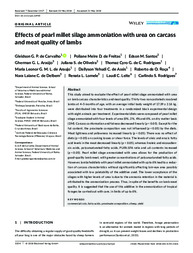Effects of pearl millet silage ammoniation with urea on carcass and meat quality of lambs.
Effects of pearl millet silage ammoniation with urea on carcass and meat quality of lambs.
Author(s): CARVALHO, G. G. P. de; FREITAS, P. M. D. de; SANTOS, E. M.; ARAUJO, G. G. L. de; OLIVEIRA, J. S. de; RODRIGUES, T. C. de C.; ARAÚJO, M. L. G. M. L. de; ASSIS, D. Y. C. de; ROÇA, R. de O.; DELBEM, N. L. C. de; LOMELE, R. L.; LEITE, L. C.; RODRIGUES, C. S.
Summary: This study aimed to evaluate the effect of pearl millet silage ammoniated with urea on lamb carcass characteristics and meat quality. Thirty-two noncastrated crossbred lambs at 4?5 months of age, with an average initial body weight of 17.39 ± 2.16 kg, were distributed into four treatments in a randomized block experimental design with eight animals per treatment. Experimental diets were composed of pearl millet silage ammoniated with four levels of urea (0%, 2%, 4% and 6%, on dry matter basis (DM). Carcass conformation and fatness decreased linearly (p < 0.05). Except for the fat content, the proximate composition was not influenced (p < 0.05) by the diets. Meat lightness and yellowness increased linearly (p < 0.05). There was no effect of diets (p > 0.05) on cooking losses or shear force. The levels of oleic and erucic fatty acid levels in the meat decreased linearly (p < 0.05), whereas linoleic and eicosadien-oic acids, polyunsaturated fatty acids, PUFA:SFA ratio and ω6 contents increased (p < 0.05). Pearl millet silage ammoniated with urea allows for the production of good-quality lamb meat, with greater concentrations of polyunsaturated fatty acids. However, lambs fed diets with pearl millet ammoniated with up to 6% lead to a reduction of carcass characteristics without significantly affecting loin-eye area possibly associated with low palatability of the additive used. The lower acceptance of the silages with higher levels of urea is due to the ammonia retention in the material is attributed to the ammonization process. Thus, in spite of the benefits on lamb meat quality, it is suggested that the use of this additive in the ammonization of tropical forages be carried out with care, in limits of up to 6%.
Publication year: 2018
Types of publication: Journal article
Unit: Embrapa Semi-arid Region
Observation
Some of Embrapa's publications are published as ePub files. To read them, use or download one of the following free software options to your computer or mobile device. Android: Google Play Books; IOS: iBooks; Windows and Linux: Calibre.
Access other publications
Access the Agricultural Research Database (BDPA) to consult Embrapa's full library collection and records.
Visit Embrapa Bookstore to purchase books and other publications sold by Embrapa.

